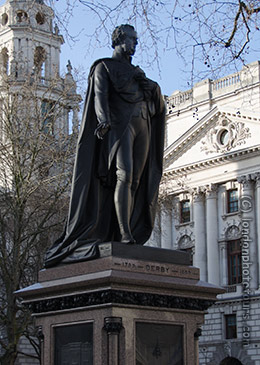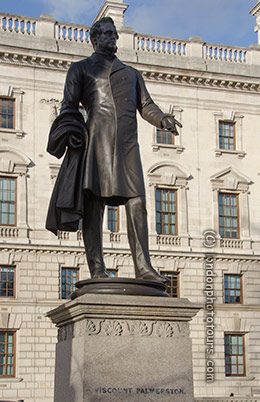London Photo Tours for Visitors
Parliament Square statues (2)
Edward Smith-Stanley (14thEarl of Derby)- 1799 -1869- By Matthew Noble - bronze 1874

Three times Prime Minister but total time in office was less than 4 years - it was a time of coallitions with no party dominating.
Lord Derby worked closely with Disraeli as his Chancellor of the Exchequor.
His main achievement was th passing of the Reform Act which icreased suffrage for the working man, doulbling the number eligilble to vote. This then extended on the all male heads of households.
The reasons behind this seems to be self-interest in suplicating popular demand by the Reform movements - expecting to give the Conservatives more power but it led to a Liberal govenment.
Viscount Palmerston (1784 - 1865)- bronze by Thomas Woolner 1876

Note: many sources quote H. Young as the sculptor: there may have been an original statue that was removed for being too small. The name 'woolner' is engraved at the round base of the statue in parliament square.
------------------------------------------------
Palmerston served in government as both a Whip and a Conservative and spent nearly 58 years in high office.
He is known for his belligerence in Foreign Affairs, his opposition to working
Class getting the vote and of womanising.
In Foreign Policy which was his abiding interest he used threats of war and gunboat diplomacy to 'persuade' others to align with British interests.
Deeply disliked by Queen Victoria, he nevertheless had overbearing influence of British Foreign policy for years.
At home he presided over reform concerning children working and some penal reform but it is hard to say what his motivation for these were considering his views on class and Empire.
Nearest Tube: Westminster exit 6